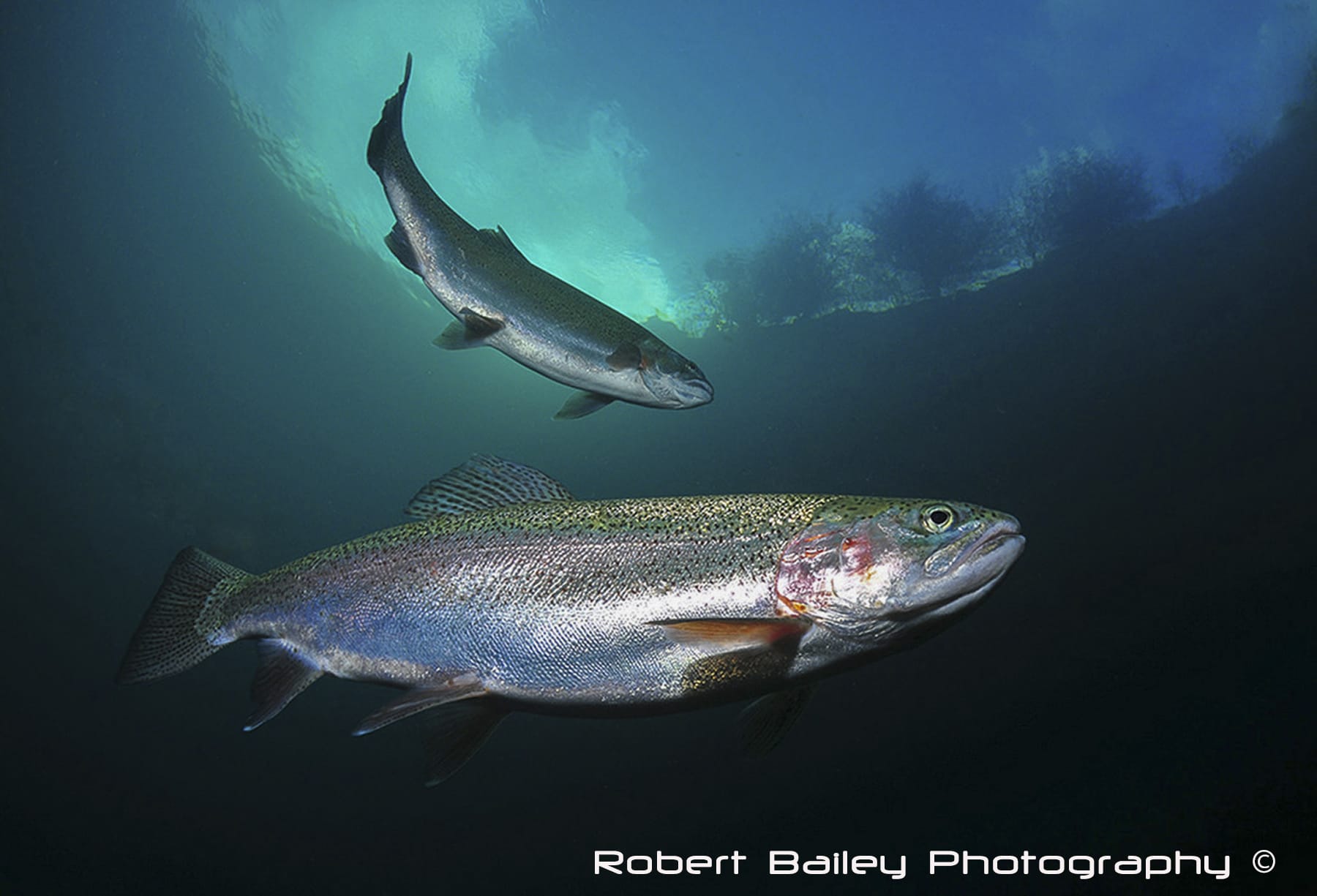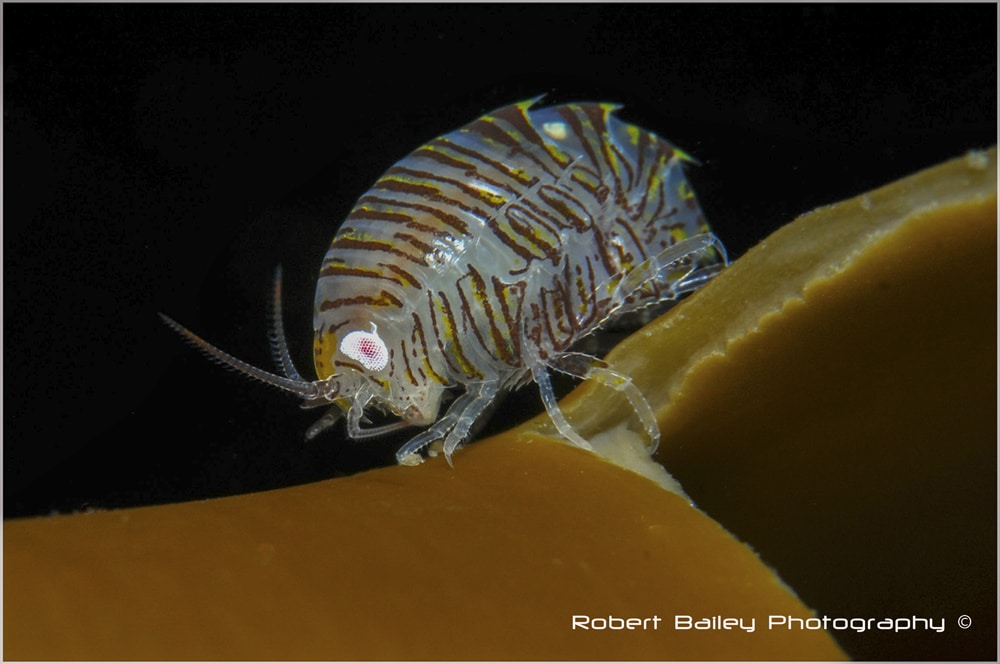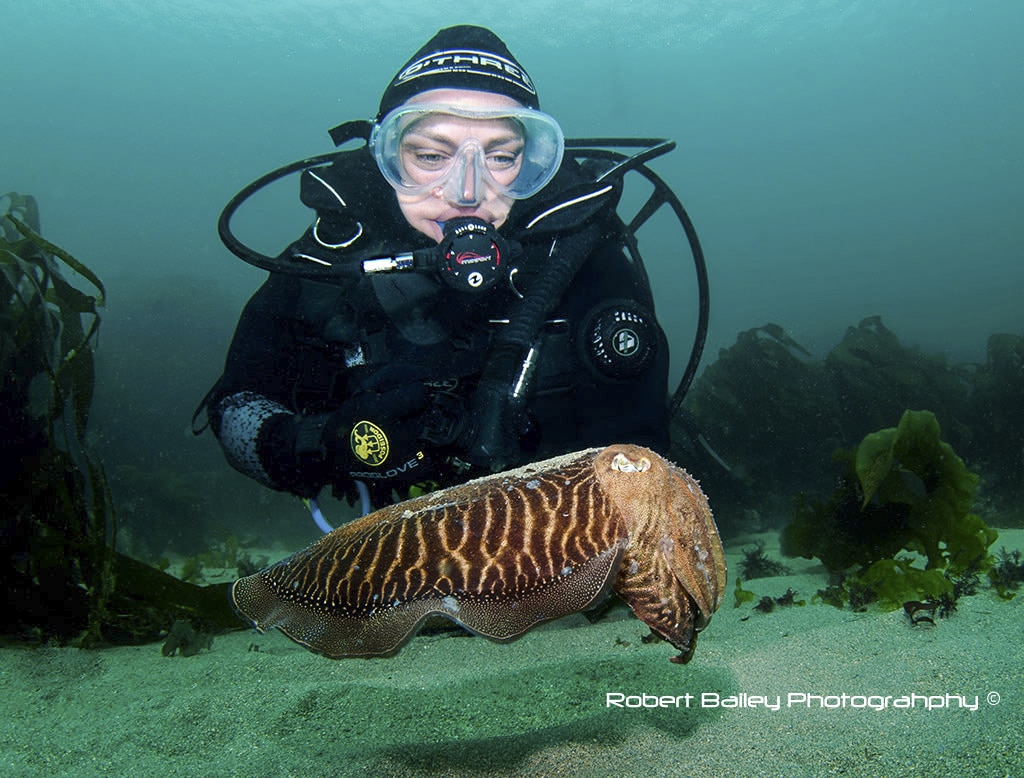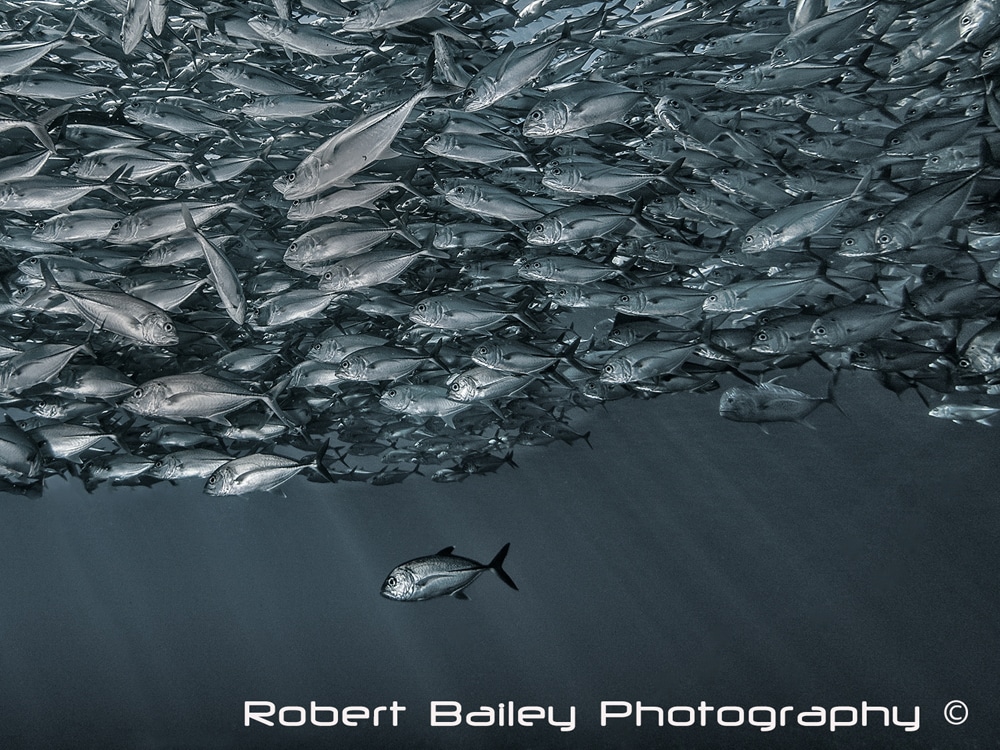Photo / Video News & Reviews
Scubaverse Underwater Photographer Interview: Robert Bailey
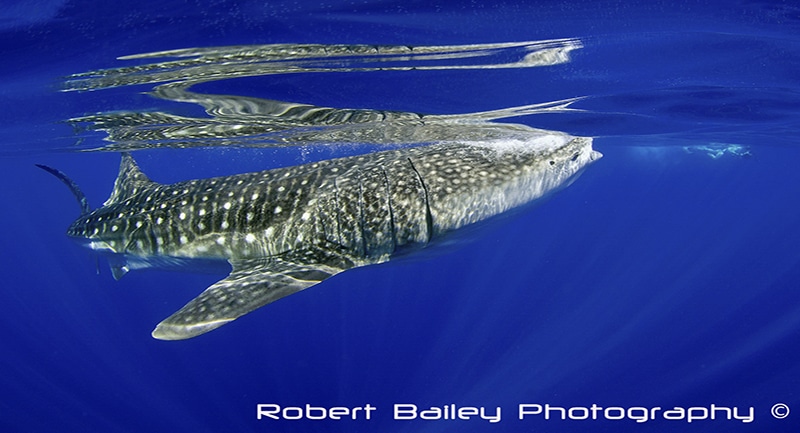
In an ongoing series, Scubaverse’s Underwater Photography Editor Nick Robertson-Brown talks to underwater photographers from around the world that he admires. In this blog: Robert Bailey.
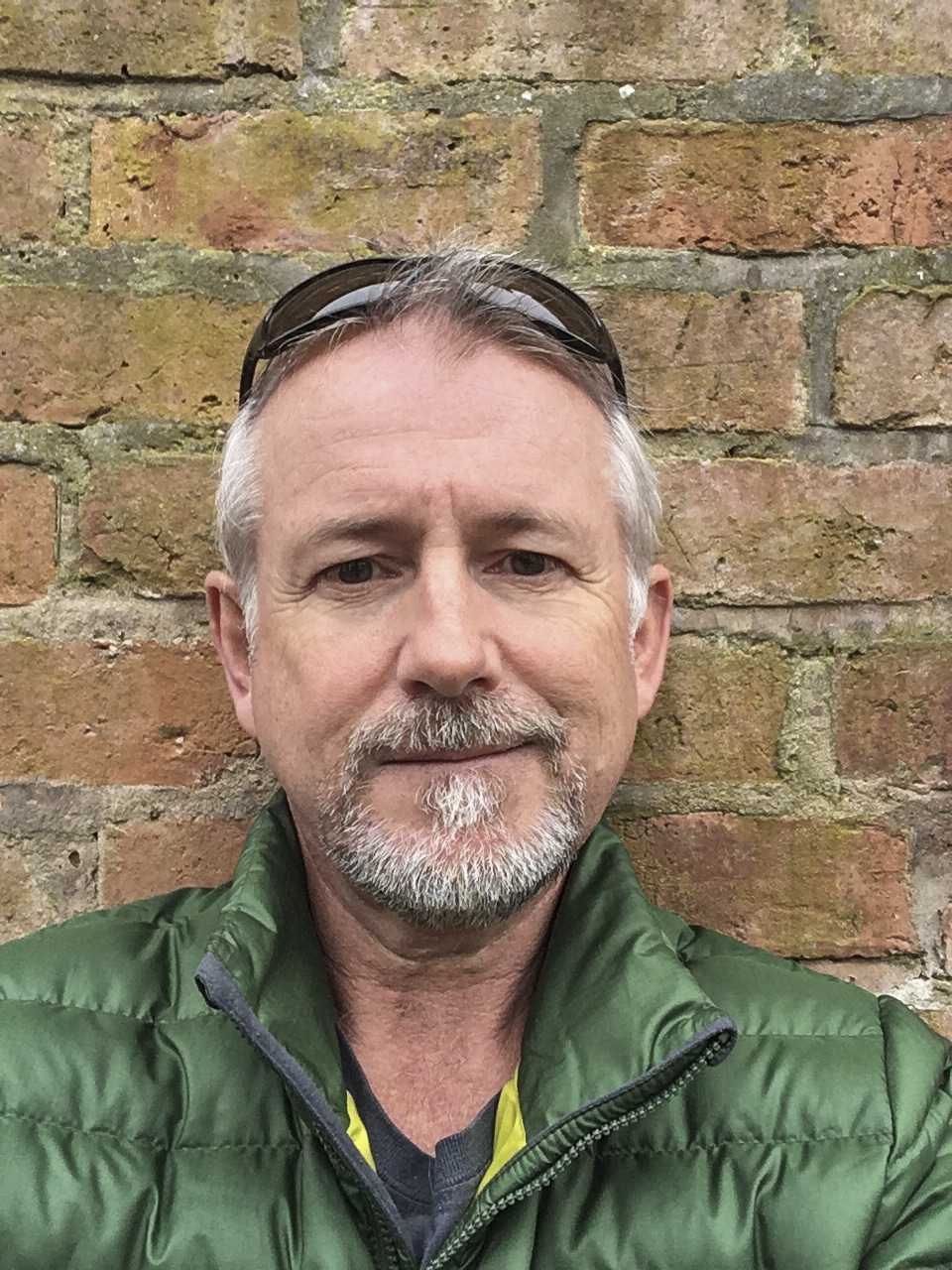 I grew up in the era of Jacque Cousteau. Those documentaries were ground breaking, they were adventurous, and they were unlocking the mysteries of the sea. Those explorations still fuel my inspiration today. In Costa Rica, in the late 80s, I hired a mask and snorkel, floundered into the sea, and didn’t come out for 3 hours. I was completely hooked. That feeling is still with me nearly 30 years on. I got certified as a diver after that trip, and decided I wanted to teach. I trained to become an instructor in the US. I worked at the University of Calgary for 6 years training up to instructor level, staffed three full-time Instructor Training Courses over the years, and taught both dive rescue and Ice diving as specialities.
I grew up in the era of Jacque Cousteau. Those documentaries were ground breaking, they were adventurous, and they were unlocking the mysteries of the sea. Those explorations still fuel my inspiration today. In Costa Rica, in the late 80s, I hired a mask and snorkel, floundered into the sea, and didn’t come out for 3 hours. I was completely hooked. That feeling is still with me nearly 30 years on. I got certified as a diver after that trip, and decided I wanted to teach. I trained to become an instructor in the US. I worked at the University of Calgary for 6 years training up to instructor level, staffed three full-time Instructor Training Courses over the years, and taught both dive rescue and Ice diving as specialities.
Being a dual citizen made the move from Canada to Europe in the late 90s an easy one, and after six years in the Netherlands I moved to the UK and have been based in the Midlands since 2005. I joined BSOUP at that time, and BUPG a little later. Entering competitions and being surrounded by accomplished photographers established the benchmark for what makes a winning image. As a result of competing my images have been published in the London Times, Sunday Times Magazine, Outdoor Photographer, Dive, Scuba, and other publications. Winning sponsorship to compete for the UK in the Epson Red Sea competition in 2009, and placing in that prestigious event was a great achievement for me. I’ve accumulated a lot of other awards in UK club competitions and other events over the years. Although I’ve travelled frequently to warmer climes, I’m drawn to colder environments. I spend the majority of my time these days diving in the UK, and Canada as these locations are less photographed and less crowded than other areas. My website is www.RobertBaileyPhotography.com , established in 2007.
NRB: How did your underwater photography start?
RB: I’ve been interested in photography since an early age. Already being a topside shooter, using a camera underwater was a natural progression for me. My underwater photography started in the early 90’s as a way of augmenting scuba training materials for the program at the University of Calgary. After a while I found my interest in UW photography overtook my desire to teach. No longer content being a diver with a camera, I evolved into an underwater photographer obsessed with getting better pictures.
NRB: What is your favourite u/w camera equipment (past & present) & why?
RB: Like most photographers I love kit. As Martin Edge once said, ‘It’s sexy’. In the film days I started out with a Nikonos V with a 35 mm lens, which is all I could afford at the time. I had varied results using that setup, but was bitten by the bug, and kept working at it every chance I got. Eventually I saved up enough to buy a 15mm lens, which was unparalleled for quality at the time. This was great to use, and I was able to make pictures I couldn’t have previously, especially close focus wide angle. After a few years I realized the limitations of working with a range finder camera underwater and set my sights on getting a housed system. I owned an Nikon F4 at time, so worked to get that into a housing with a Sport Finder (a lovely- and not cheap – optical view finder) I was able to get pictures more easily, especially of quick moving tiny fish, which proved a great challenge for me using the Nikonos.
My favourite camera out of them all is the one I use now, the Nikon D500. it’s nice to be able to take advantage of the latest digital technology. The autofocus system, in my experience, is better than anything I’ve used previously underwater. Having immediate feedback underwater is much easier than working with film. My work horse wide angle lens is the Tokina 10-17 mm fisheye, which is renowned for its close focus ability. I still use an old style Nikkor 60mm Macro lens which has excellent optics. I’ve used various brands of strobes over the years, but settled on Inon strobes which I’ve found to be hugely reliable, and easy to use. My Z240s are my go-to lights, and I use two S2000’s for off camera work. The Nauticam Super Macro Convertor (SMC) is a fantastic tool for unlocking the tiny marine life world not immediately apparent to the naked eye. When I dive with this, I feel like a kid looking at the underworld world through a microscope. I like kit that’s reliable, and built to last.
NRB: What would be your advice to anyone new to underwater photography?
RB: Revisit the fundamentals. Ensure your dive equipment is in order. Confirm you’re correctly weighted for conditions. Achieving neutral buoyancy in my opinion is key to good photography underwater, and more importantly preserving the underwater environment, and conditions for other photographers who may be around you. You’d be surprised how often this is overlooked. Get in the water as much as you can, and always dive with a camera. Creating opportunities underwater is more important than the equipment you don’t have. Fully exploit the equipment you do have. Join an underwater photography club, submit images to competitions, and solicit as much feedback as possible about what you can do to improve. There’s a lot of talent around these days, many photographers are generous with their knowledge and love to wax lyrical about their experiences. Join trips with other underwater photographers. These trips are often setup by clubs to maximize photographic opportunities. Read and research. There are a lot of good books around, and I highly recommend the latest books from Alex Mustard and Martin Edge. Read these cover to cover. The internet also contains a wealth of knowledge. Table top experimentation can be massively helpful in familiarizing you with your equipment. When your diving, set your equipment up on the surface for what your trying to achieve. Minimize adjustments underwater where possible. Having a plan and being deliberate has helped me over the years.
NRB: What, or who, has been your single biggest inspiration for your underwater photography?
RB: I think when I first got into it, I was hugely inspired by the work of David Doubilet. His underwater stories in National Geographic were only available though the post, so those articles were like gold when they arrived. Doubilet’s book Water Light Time is still a favourite of mine, and now a well worn tome. In more recent years Alex Mustard, Flip Nicklin, and Thomas Peschak are a few of the underwater photographers I really admire. There’s so much talent out there these days. Starting to place and win competitions certainly has fuelled my passion in the past, and trying to stay in the top set of local photographers keeps me coming back today.
NRB: What image are you most proud of and why?
RB: Without hesitation a picture I made of a whale shark whilst on a live aboard in Egypt. Quite early one morning in the Gulf of Suez on mirror calm seas the skipper killed the engine. From our cabin I could hear a lot of chatter on deck, and went up to see what was going on. To my amazement four whale sharks were going about their business. We jumped in the rib and did some snorkelling with these gentle giants. Amidst the excitement I got the cox to take me back to the boat, and I did the fastest lens change in history and jumped back in equipped with a wide angle lens. I managed to make a few pictures complete with surface reflections. Having only seen Basking Sharks in the UK for the first time the week before, I quite excited by the whole affair. I still look at these pictures and remind myself I was there.
NRB: Where is your favourite dive location, and is it for the photography?
RB: It’s hard to settle on just one place. I’ve been fortunate to travel a lot during my diving career. The diving and topside experience off northern Vancouver Island in Canada has been remarkable over the years, and tops my list. The marine life there is prolific and many of the subjects are less photographed than those in the tropics. Being surrounded underwater by dozens of Pacific white sided dolphins ranks high on my list of underwater experiences. There are no crowds to speak of, the topside wildlife is abundant. Over the last few years we’ve run trips where we’ve seen coastal wolves, California sea otters, bald eagles, coastal deer, black bears, humpback whales, and orcas to name a few. I think Queen Charlotte Strait and Slingsby Channel would rival any topside safari. It’s home for me, and a lot of my formative experiences as a diver and photographer took place there.
NRB: What are you views on marine life manipulation, moving subjects?
RB: I do my utmost to respect the creatures I photograph, and not interfere with any marine life. I leave subjects alone that are inaccessible with a camera. I think humanity needs to be more courteous to the other inhabitants we share our planet with. Jeopardizing life for the sake of a photograph is not acceptable practice to me.
NRB: What do you look for when you are making your images?
RB: Clean, uncluttered backgrounds. Colour. High Contrast. Anthropomorphism
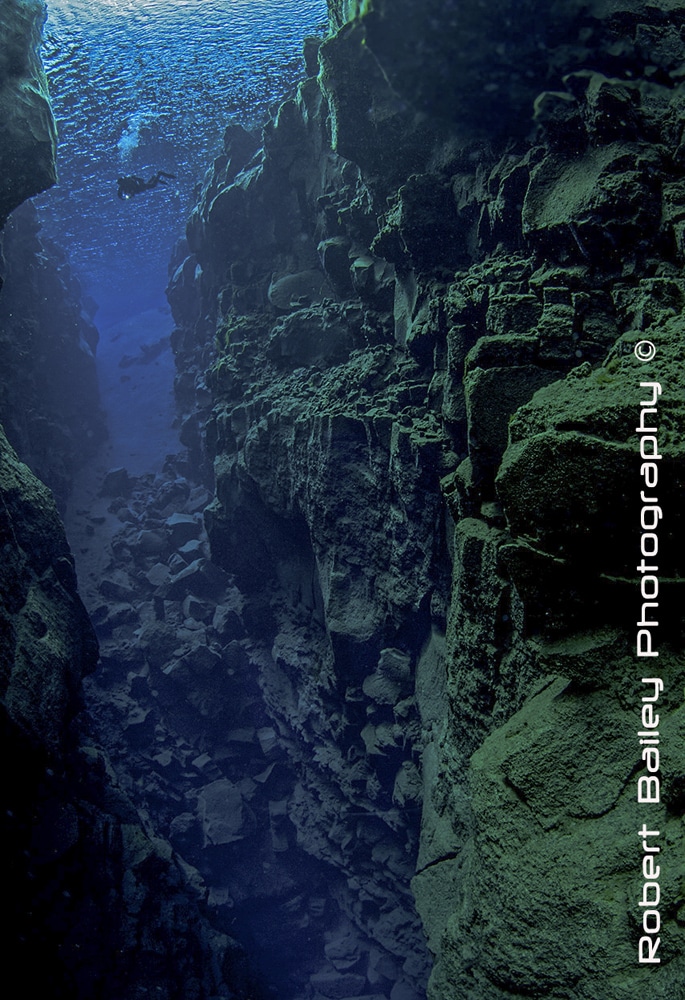 NRB: What motivates you to take u/w photos?
NRB: What motivates you to take u/w photos?
RB: My love of nature, photography, diving, being outdoors, and the great friends and family I’ve shared my experiences with.
NRB: If you could photograph any one thing/place what or where would that be?
RB: A blue whale is my ultimate dream. and I’d like to photograph it in a remote area, maybe in a polar region. Having said that I’d settle on being in the water anywhere, with any whale. I’ve seen a lot whales on the surface, and have been close enough to Orcas to smell their breath. I’m in awe of whales, and would love the experience of being close to them underwater.
Find out more about Robert Bailey by clicking here.
Blogs
Diver Discovering Whale Skeletons Beneath Ice Judged World’s Best Underwater Photograph
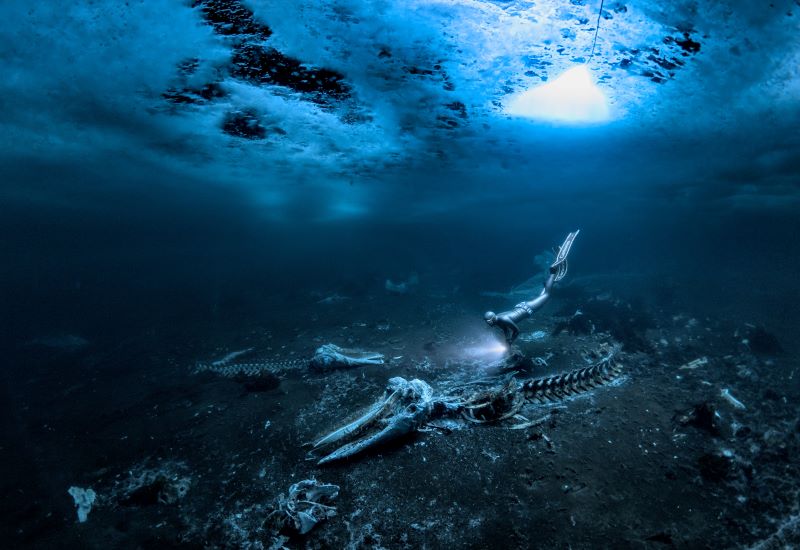
An emotive photograph showing a freediver examining the aftermath of whaling sees
Alex Dawson from Sweden named Underwater Photographer of the Year 2024. Dawson’s
photograph ‘Whale Bones’ triumphed over 6500 underwater pictures entered by underwater
photographers from around the world.
“Whale Bones was photographed in the toughest conditions,” explains chair of judging
panel Alex Mustard, “as a breath-hold diver descends below the Greenland ice sheet to bear
witness to the carcasses. The composition invites us to consider our impact on the great
creatures of this planet. Since the rise of humans, wild animals have declined by 85%. Today,
just 4% of mammals are wildlife, the remaining 96% are humans and our livestock. Our way
needs to change to find a balance with nature.”
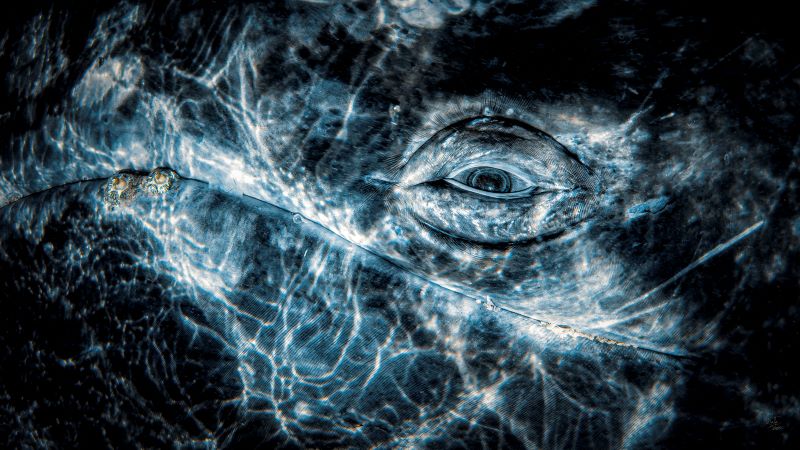
Photo: Rafael
Fernandez Caballero
Whales dominated the winning pictures this year with Spanish photographer Rafael
Fernandez Caballero winning two categories with his revealing photos of these ocean giants:
a close up of a grey whale’s eye and an action shot of a Bryde’s whale engulfing an entire bait
ball, both taken in Magdalena Bay, Baja California, Mexico. Fernandez Caballero took ‘Grey
Whale Connection’ while drifting in a small boat, holding his camera over the side in the water
to photograph the curious whale. ‘The End Of A Baitball’ required Fernandez Caballero to dive
down and be in exactly the right place at the moment the whale lunged. “The photo shows
the high speed attack,” he said, “with the whale engulfing hundreds of kilograms of sardines
in one bite — simply unforgettable to see predation on such a scale.”
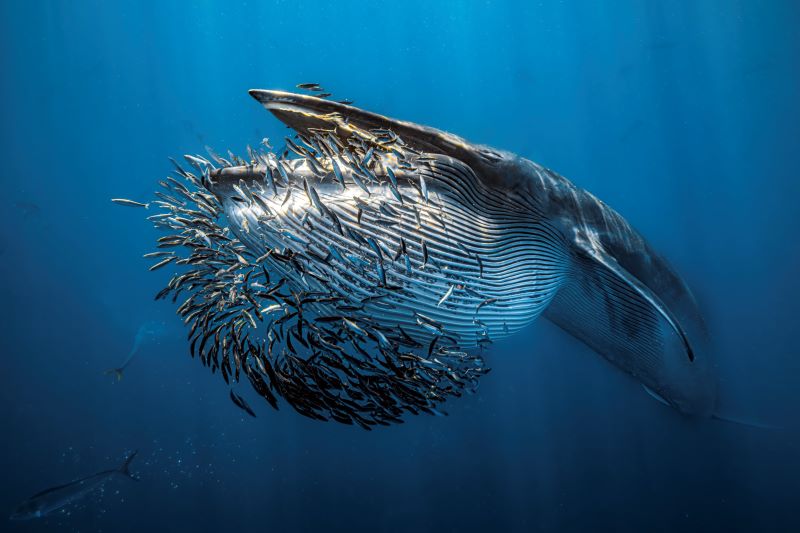
Photo: Rafael
Fernandez Caballero
Lisa Stengel from the United States was named Up & Coming Underwater Photographer of the Year 2024 for her image of a mahi-mahi catching a sardine, in Mexico. Stengel used both a very fast shutter speed and her hearing to catch the moment. “If you listen there’s an enormous amount of sound in the ocean,” she explained. “The action was too fast to see, so I honed in on the sound of the attacks with my camera to capture this special moment.”
“It is such an exciting time in underwater photography because photographers are capturing such amazing new images, by visiting new locations and using the latest cameras,”
commented judge Alex Mustard. “Until this year I’d hardly ever see a photo of a mahi mahi,
now Lisa has photographed one hunting, action that plays out in the blink of an eye.”
The Underwater Photographer of the Year contest is based in the UK, and Jenny Stock,
was named as British Underwater Photographer of the Year 2024 for her image “Star
Attraction”, which finds beauty in species of British wildlife that are often overlooked.
Exploring the west coast of Scotland, Stock explained “in the dark green depths my torch
picked out the vivid colours of a living carpet of thousands of brittle stars, each with a
different pattern. I was happily snapping away, when I spotted this purple sea urchin and I
got really excited.”
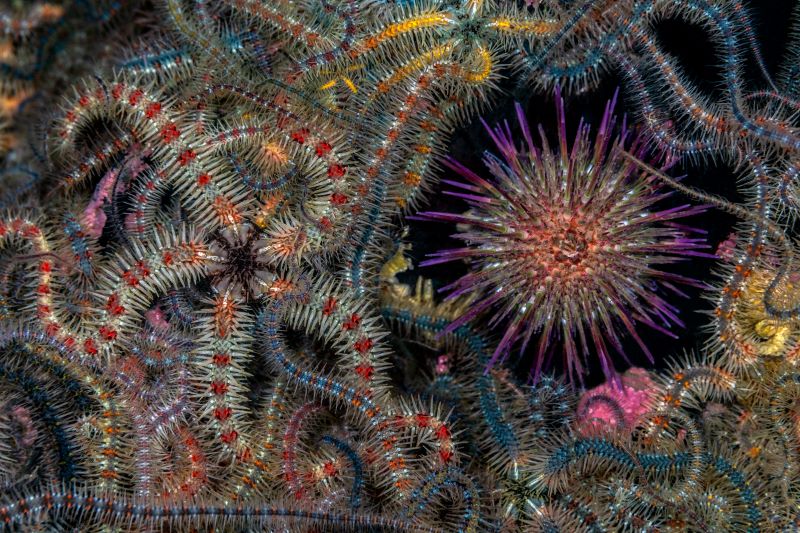
Photo: Jenny Stock
In the same contest, Portuguese photographer, Nuno Sá, was named ‘Save Our Seas
Foundation’ Marine Conservation Photographer of the Year 2024, with his photo ‘Saving
Goliath’, taken in Portugal. Sá’s photo shows beachgoers trying to save a stranded sperm
whale. The picture gives us hope that people do care and want to help the oceans, but also
warns us that bigger changes are needed. “The whale had been struck by a ship and its fate
was sealed,” explains Sá. “An estimated 20,000 whales are killed every year, and many more
injured, after being struck by ships-and few people even realise that it happens.”
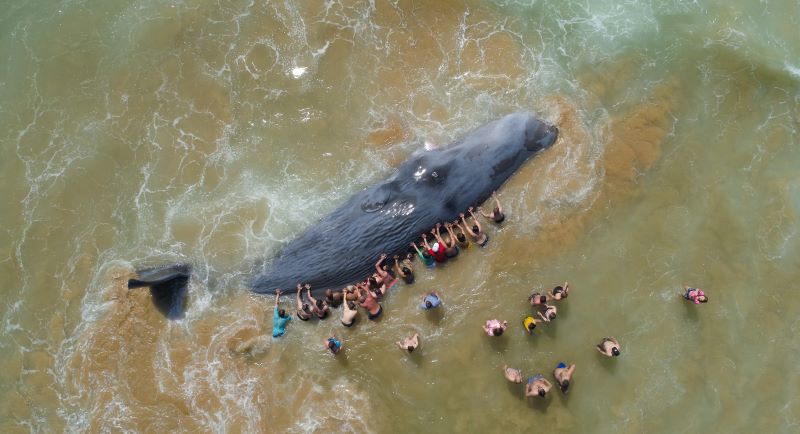
Photo: Nuno Sá
More winning images can be found at www.underwaterphotographeroftheyear.com.
About Underwater Photographer of the Year
Underwater Photographer of the Year is an annual competition, based in the UK, that celebrates photography beneath the surface of the ocean, lakes, rivers and even swimming pools, and attracts entries from all around the world. The contest has 13 categories, testing photographers with themes such as Macro, Wide Angle, Behaviour and Wreck photography, as well as four categories for photos taken specifically in British waters. The winners were announced in an award ceremony in Mayfair, London, hosted by The Crown Estate. This year’s UPY judges were experienced underwater photographers Peter Rowlands, Tobias Friedrich and Dr Alexander Mustard MBE.
Header image: Underwater Photographer of the Year 2024 winner Alex Dawson
News
World’s Best Underwater Photographers Unveil Breathtaking Images at World Shootout 2023
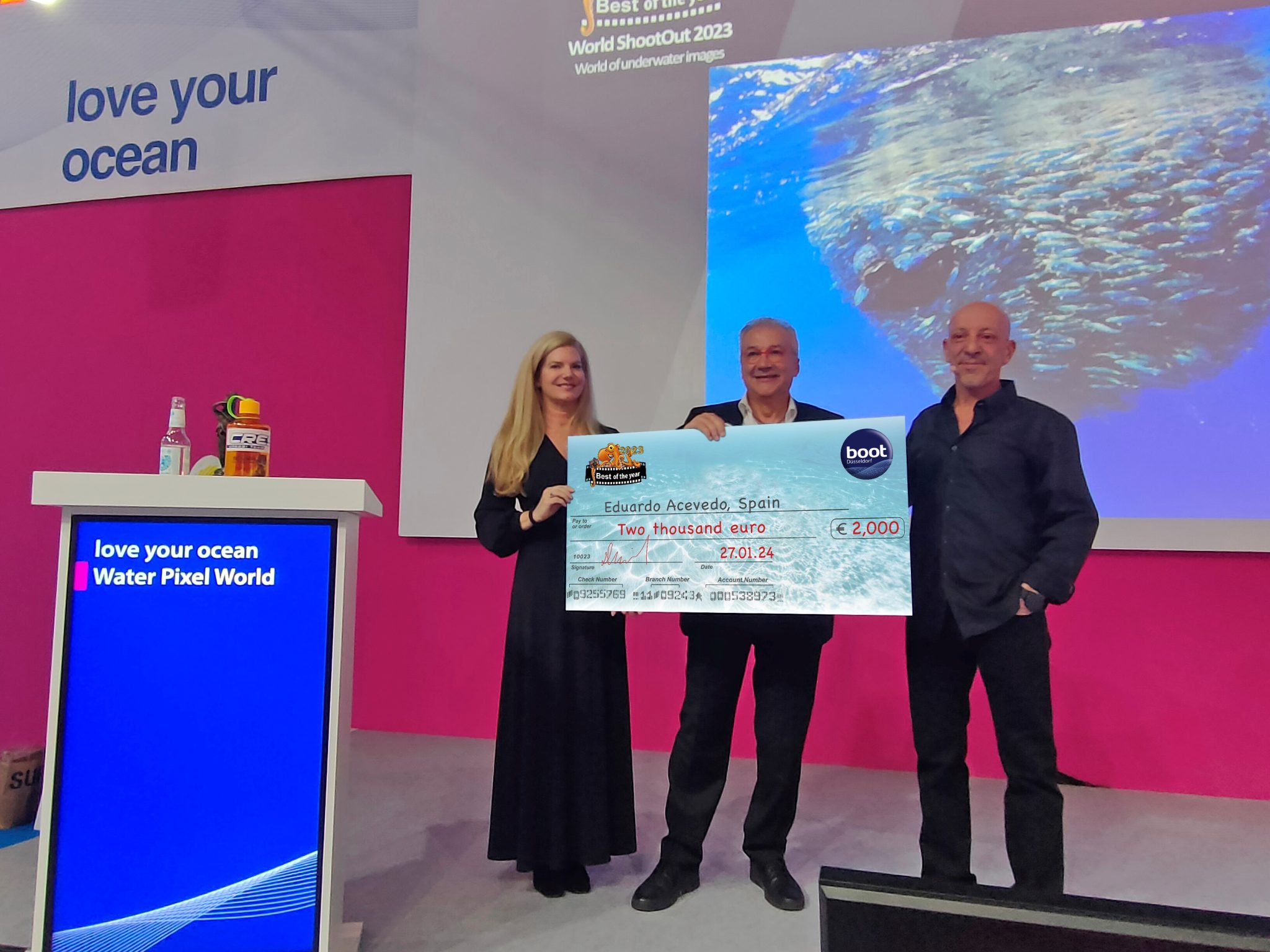
The winners of the prestigious World Shootout 2023 underwater photography competition were announced at this year’s BOOT Show, captivating audiences at the world’s largest diving and water sports exhibition in Dusseldorf, Germany. Hundreds of photographers from 54 countries competed across nine categories, pushing the boundaries of creativity and technical skill.
Grand Prize Winners
- Picture of the Year: Spanish photographer Eduardo Acevedo “secured” the top Honor with the prestigious prize the “boot Dusseldorf Director’s Prize, earning an Andromeda statuette and a €2,000 cash prize.
- Best 5 Images Portfolio: Luc Rooman from Belgium triumphed in this category, winning a dream 4-week diving trip for two to Papua New Guinea, valued at $18,900.
- Amateur Photographer: Alexandra Ceurvorst from the USA impressed the judges with her talent, taking home the 1,000 € cash prize award.
Celebrating Diversity and Innovation
This year’s competition saw 11,680 entries from 964 photographers, showcasing a remarkable spectrum of skills and perspectives. From the intricate wonders of Macro photography to the beauty of “Black Water”, the “Underwater Fashion” category added a touch of artistry and innovation, while the ever-important ” Environmental & Conservation” category served as a powerful reminder of the need to protect these fragile ecosystems.
Looking Ahead: AI and Ocean Conservation
World Shootout founder and producer David Pilosof unveiled an exciting addition for the 2024 competition: this year the Environmental category will be focusing on the impact of plastic on our oceans and future.
This category will embrace the potential of AI or other editing software as a tool to amplify the conservation message.
Entrants will submit campaigns of three original underwater photographs dealing with plastic pollution, along with their final AI assistance processing. This innovative approach encourages artistic expression while raising awareness about a critical environmental issue.
Explore the Stunning Collection
Discover the complete album of competition entries by clicking here.
For Low-resolution photos of finalist entries in eight categories, click here.
-

 News3 months ago
News3 months agoHone your underwater photography skills with Alphamarine Photography at Red Sea Diving Safari in March
-

 News2 months ago
News2 months agoCapturing Critters in Lembeh Underwater Photography Workshop 2024: Event Roundup
-

 Marine Life & Conservation Blogs2 months ago
Marine Life & Conservation Blogs2 months agoCreature Feature: Swell Sharks
-

 Blogs2 months ago
Blogs2 months agoMurex Resorts: Passport to Paradise!
-

 Blogs2 months ago
Blogs2 months agoDiver Discovering Whale Skeletons Beneath Ice Judged World’s Best Underwater Photograph
-

 Gear News3 months ago
Gear News3 months agoBare X-Mission Drysuit: Ideal for Both Technical and Recreational Divers
-

 Gear Reviews2 months ago
Gear Reviews2 months agoGear Review: Oceanic+ Dive Housing for iPhone
-

 Marine Life & Conservation2 months ago
Marine Life & Conservation2 months agoSave the Manatee Club launches brand new webcams at Silver Springs State Park, Florida


